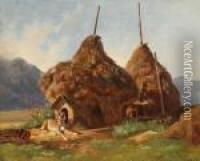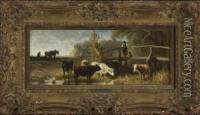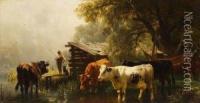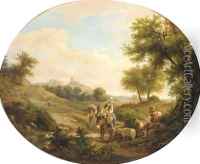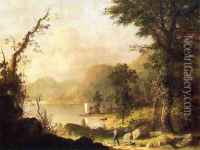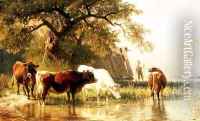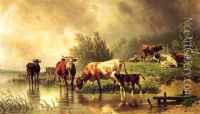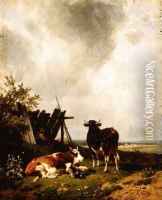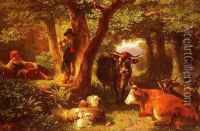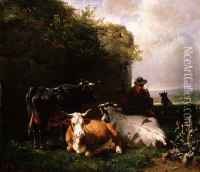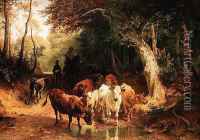Friedrich Johann Voltz Paintings
Friedrich Johann Voltz was a 19th-century German painter, best known for his pastoral scenes and animal paintings, particularly of cattle. Born on October 31, 1817, in Nördlingen, Bavaria, Voltz was the son of the painter Johann Michael Voltz, who was well-regarded for his engravings and lithographs. Friedrich showed an early interest in art, likely influenced by his father's work. He began his formal education at the Munich Academy of Fine Arts in 1834, where he studied under several respected artists of the time, including Wilhelm von Kaulbach.
Voltz's passion for depicting animals, especially cows and sheep, stemmed from his rural upbringing and his exposure to the Bavarian countryside. His works often reflect a romantic view of rural life, emphasizing the harmony between the animals and their natural surroundings. He traveled throughout Germany, Switzerland, and Italy to capture various pastoral scenes, which became popular among art collectors and the public.
In 1858, Voltz was appointed as a Royal Professor by the Bavarian court, an acknowledgment of his artistic contributions and growing reputation. His style evolved over the years from a detailed realism to a more atmospheric approach, showing the influence of the Barbizon school, which focused on naturalistic and tonal qualities in landscape painting.
Throughout his career, Voltz exhibited his work at various art exhibitions, including those held by the Munich Art Association and the Berlin Academy of Art. His paintings were well-received, and he gained admirers and patrons from different strata of society, including the Bavarian royal family.
Friedrich Johann Voltz died on June 25, 1886, in Munich, leaving behind a legacy of rich pastoral art that continues to be appreciated for its serene beauty and technical skill. His works can be found in numerous art collections and museums across Germany and beyond, serving as a testament to his dedication to capturing the essence of 19th-century rural life.

